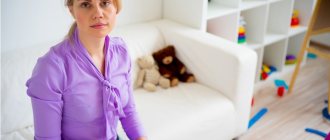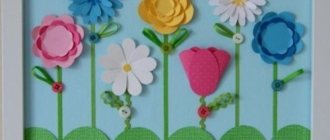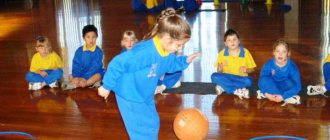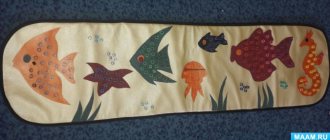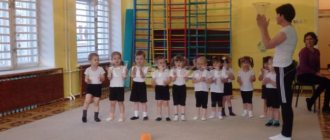Consultation for teachers “Non-traditional forms of work in physical education in preschool educational institutions”
Municipal budgetary preschool educational institution
"Kindergarten No. 16"
Consultation for teachers
“Non-traditional forms of work in physical education in preschool educational institutions”
Prepared by the teacher:
Belikova Yulia Anatolevna
Novorossiysk
2017
Non-traditional forms of work
in physical education at preschool educational institutions
In preschool age, the foundation of health is laid: the life systems and functions of the body mature and improve, its adaptive capabilities develop, its resistance to external influences increases, posture is formed, physical qualities and habits are acquired, and strong-willed character traits are developed, without which a healthy lifestyle is impossible.
Physical activity is the main source and motivating force for protecting and promoting health, improving the physical and intellectual abilities of a person. A child gets to know the world, masters speech, spatio-temporal connections of objects and phenomena with the help of movements; this is ingrained in him from preschool age. It is necessary to develop the physical culture of a preschooler, providing, first of all, for the formation of an attitude towards motor-active activity, interest and need for physical self-improvement, enjoying games, exercises, and activities. We introduce the child to physical education constantly, hourly, every minute. It permeates his entire life, all types of activities, recreation.
Currently, despite the variety of programs being implemented in preschool institutions, the problem of children's physical education remains relevant. This is confirmed by the trend of worsening health status and a decrease in the level of physical activity of preschool children. There is an increasing need, starting from a very early age, to ensure that preschoolers have a stable interest, the need for regular physical exercise, and the value of motivation for a healthy lifestyle. Physical education classes are dry, monotonous, and as a result of this, there is no interest or desire to engage in physical education. That is why the use of alternative physical education activities of a non-traditional orientation becomes especially important for preschool educational institutions. Non-traditionality implies a difference from the classical structure of the lesson through the use of new ways of organizing children, non-standard equipment, making some changes to the traditional form of structure of the lesson, leaving the main thing unchanged.
To do this, it is necessary to conduct classes in various options, in a non-traditional form: Olympiads, hikes, health days, travel, you need to give children the opportunity to improvise in classes. Using these techniques, classes turn out to be interesting, provide great emotional stress, and give children joy.
As a teacher, I am more interested in the question of what types of non-traditional health system can be presented in a preschool institution in addition to physical education classes.
- Technology for preserving and promoting health:
Rhythmic movements to music
. Movements in combination with words and music represent a holistic educational and developmental process: children are favorably influenced by the tempo, rhythm, dynamics of music and words, the arrhythmic pulsation with which the movements are associated causes a coordinated reaction of the whole organism.
Musical and outdoor games
- contain exercises used in almost all classes and are the leading activity of a preschooler. Here, techniques of imitation, imitation, figurative comparisons, role-playing situations, competitions are used - everything that is required to achieve the goal when conducting dance and play gymnastics classes.
Relaxation
is one of the ways to overcome internal tension, based on more or less conscious muscle relaxation. Even preschoolers living in the modern civilized world experience increased mental and physical stress; constant rush, anxiety, a flow of negative information from the television screen, frequent infectious diseases, fatigue, which subsequently leads to overexertion. By teaching children the relaxation method, we help them relieve internal muscle tension, calm down, thereby bringing the nervous system and psyche into a normal state of rest. Children’s ability to manage their feelings and emotions is another step towards developing their self-confidence.
Relaxation before bed - with
it is the body’s natural rest. It protects brain cells from exhaustion and destruction, restores energy expended during wakefulness. During sleep, all metabolic processes are normalized. Systematic lack of sleep leads to health problems, therefore, great importance should be given to organizing children’s sleep. You can use a calm melody for relaxation or recite the autogenic training formula in images, as well as use pendulums and scented pads.
Phytoncidotherapy.
Onion leaves and bulbs contain concentrated vitamins, mineral salts, nutrients and a large number of phytoncides that suppress the growth of pathogenic microorganisms. Each type of onion has its own medicinal properties and characteristics. The juice and gruel must be freshly prepared, because when exposed to air for 10–15 minutes, volatile bactericidal substances evaporate.
Garlic is a disinfecting, bacteria-killing medicinal plant. It is used in the treatment and prevention of many diseases.
Aroma - therapy and phyto - therapy
— nature is always ready to generously give a natural remedy for healing to both children and adults. For children who often suffer from acute respiratory viral infections, phytotherapy is recommended for general health improvement and increased immunity. Melissa, chamomile, calendula flowers, mint, oregano, St. John's wort - have anti-inflammatory effects. Rosehip, motherwort, chamomile, calendula, lemon balm - have restorative and sedative effects. Also, medicinal herbs are used for healing pads, which have soothing and bactericidal properties.
Finger gymnastics
- This section serves to develop manual skills, fine motor skills and hand coordination. Exercises, turning the learning process into an exciting game, not only enrich the child’s inner world, but also have a positive effect on improving memory, thinking, and developing imagination.
Breathing and sound gymnastics.
With the help of this gymnastics, the child’s overall vitality, resistance and resistance to colds increase. Children develop respiratory muscles, increase the mobility of the chest and diaphragm, and improve blood circulation in the lungs. This gymnastics restores impaired nasal breathing, has a positive effect on metabolic processes, corrects deformations of the chest and spine that have developed in the course of diseases, and improves the neuropsychic state.
Gymnastics for the eyes
- Helps relieve tension in the eye muscles during prolonged eye strain.
Health running (dosed)
– give children an emotional charge of vigor and spiritual balance; train breathing, strengthen muscles, bones, joints. Recreational running should be carried out with a small subgroup of children (5–7) people, taking into account the physical level of fitness of the children. In older preschool age, they run at an average pace (2.4–2.7 m/s) without stopping for significant distances - from 950 m to 1600 m - in a period of time from 5 to 11 minutes.
Pouring cold water
– promotes awakening of the nervous system, mobilization of the body’s internal forces. The dousing is usually carried out for 20–30 s. After it, the child quickly wipes himself dry.
Game stretching
— stretching exercises are imitative in nature and are performed during a role-playing game, consisting of interconnected game situations, tasks, and exercises. Selected in such a way as to help solve health and development problems. By imitating the image, the child begins to learn the technique of movements in sports and dance exercises, games, theatrical activities, etc. Imaginative and imitative movements develop creative, motor activity, creative thinking, motor memory, reaction speed, orientation in movement and space, and attention.
Orthopedic gymnastics
. The goal of orthopedic gymnastics is to strengthen the muscles of the arch of the foot in children through a set of special exercises.
- Healthy lifestyle training technology:
Game therapy (problematic-game activities).
Method of psychotherapeutic influence on children and adults using games. The game promotes the creation of close relationships between group members, relieves tension, anxiety, fear of others, increases self-esteem, allows you to test yourself in various communication situations, removing socially significant consequences.
A characteristic feature of the game is its two-dimensionality. Distinctive signs of the unfolding of the game are the rapidly changing situations in which the object finds itself after acting on it, and the equally rapid adaptation of actions to the new situation.
The goal of play therapy is to affirm the child’s unique “I” and self-worth; serve the interests of children.
Self-massage, acupressure.
Self-massage is an important means of physical education; it helps to expand the capillaries of the skin, accelerates blood circulation, enhances the functions of the glands, which has a positive effect on metabolism. Acupressure is pressing with fingertips on the skin and muscle layer at the location of tactile points and nerve branches. This type of massage gives good results in a gaming situation and by mentally pronouncing affectionate words. This element of psychophysical training helps to relax muscles and relieve neuro-emotional tension.
A set of exercises to develop fine motor skills of the hands
– these are games with sticks, octagonal pencils; drawing on grain, sand; rolling walnuts and stones in the palms; games using clothespins; games using sponges, pipettes; games using a dry pool (corks, cereals, small objects); balls with buttons; massage balls.
- Corrective technology:
Fairy tale therapy
- today fairy tale therapy is one of the main means of psychotherapeutic influence used to correct various mental processes and behavioral reactions of the child. This method of psychocorrection is based on the fact that a fictional story carries a hidden meaning in solving complex problems. Reading fairy tales helps a child overcome life's difficulties and find a way out of difficult situations.
Music therapy
is a medicine that is listened to. At the end of the last century, Russian physiologist I.R. Tarkhanov, with his original research, proved that melodies that bring joy to a person slow down the pulse, increase the strength of heart contractions, contribute to the dilation of blood vessels and normalize blood pressure, while irritating music gives the exact opposite effect. Music that is readily listened to stimulates the secretion of digestive juices and increases appetite. It was noticed that music acts selectively - depending not only on the character, but also on the instrument on which it is performed.
Playing the clarinet affects blood circulation. Violin and piano are the best for soothing. And the flute has the most relaxing effect.
The greatest effect of music is in the prevention and treatment of neuropsychiatric diseases. Music can calm, relax and activate, relieve sadness and cause an influx of energy, or even excite, create tension, cause aggressiveness. Music affects people more acutely than words.
Color therapy
– this is a healing color. Color has long been given a mystical meaning and a beneficial only negative effect on humans. Some flowers caress the eye, soothe, promote a surge of internal strength, others irritate and evoke not the best emotions. Some are invigorating, others are depressing. Moreover, they act this way on some, and differently on others. In short, the influence of color is selective.
Red color is useful for all inflammatory diseases, including smallpox and lupus. A patient suffering from them is placed in a room where everything is red, and all the rays penetrating here must be red.
Blue color has a special calming effect. Mental workers will find it easier to work in a room with a blue lamp or blue curtains on the windows. This is an excellent remedy for psychosis. And even the craziest maniacs will be overcome by the calming influence if their felt-lined riot room is illuminated with blue light. This color is also beneficial for weak eyes.
Green color is effective in treating eye inflammation. Orange sharpens the appetite. Yellow heals the intestines.
Laughter therapy.
Accelerates recovery, helps to cope with difficulties, and maintain peace of mind. They do not replace treatment, but serve as a strong and pleasant additional remedy. Laughter allows you to completely relax.
Training
- an element of mental discipline that can and should be taught to preschoolers, the ability to exaggerate the positive and dissolve, disperse the negative.
When performing trainings, it is important for children to be able to imagine the situation being described, which in turn gives them the opportunity to calm down, relieve excess stress and improve their mood.
Autotraining
– influence the subconscious by relaxing muscles, breathing, teaching how to relax. After physical activity, you need to sit in a chair, or lie down, isolated from extraneous noise, relax, and distract yourself from disturbing thoughts; breathe deeply and calmly.
Non-traditional physical education activity
Non-traditional physical education lesson in the second junior group “Kolobok”
Prepared by Olga Vladimirovna Shvedova
SOFTWARE CONTENT:
1) To form children’s motor skills and abilities, to develop psychophysical qualities; 2) To improve walking one after another, in a circle, in a normal step; 3) To develop agility, coordination of movements; 4) To cultivate respect for each other, courage, endurance, and a healthy image life.
MATERIALS AND EQUIPMENT:
Arc, Kolobok toy, balls, “snake”.
PROGRESS OF THE CLASS:
Educator. Today we will visit the fairy tale “Kolobok”. And it started like this. Once upon a time there lived a grandfather and a woman. Grandfather asked grandmother to bake a Kolobok. “We walk along a narrow path” - walking on tiptoes. (hands on the belt, backs straight, shoulders straight)
“Walking on the pebbles” - walking on heels. (hands behind your back)
“We walk through dense bushes” - walking in a half-squat. (stretch your arms)
“We walk around dry fallen branches” - walking with high knees. (hands on belt)
“Running out into a sunny meadow” - easy running on your toes.
I was tired and decided to rest and breathe in the fresh forest air.
Exercise to restore breathing. - Repeat 2-3 times. General developmental exercises with a ball:
1) Educator. Kolobok is resting. Suddenly Bunny jumps out to meet you. Kolobok wanted to see what kind of ears the Hare has.
I. p.: legs together, stand on your toes, raise your arms up, then lower them down.
Repeat 4-6 times. 2) Educator. "Gray Wolf" entered the clearing
I. p.: feet shoulder-width apart, ball in hands. Turns to the sides: "oo-oo-oo"
Return to i. n. The same to the left.
Repeat 3-4 times in each direction. 3) The “Bear-Toed Bear” entered the clearing
I. p.: sitting, legs straight, ball in hands. - Bends forward, touching toes with ball.
Repeat 4-6 times. 4) “Sister Fox” came out into the clearing. She liked Kolobok. She began to jump with him.
I. p.: feet together, ball in hands in front.
Perform jumping on two legs in combination with walking in place.
Repeat 3 times, 4 jumps each, alternating with walking in place.
MAIN PART
1) Walking along the snake with the left and right sides; 2) Roll Kolobok into the gate -2 times 3) Climb under an arc on all fours; (catch up with Kolobok) -2 times 4) Collect Koloboks; (please note that we now have a lot of Koloboks) ACTIVE GAME:
“Pass the Kolobok”, sitting on the floor with your feet, pass the Kolobok to each other.
Final part Educator: Here, guys, we came up with another, good ending to the fairy tale. And now we will take our koloboks to our grandparents. Let's say goodbye to our guests. Walking like a snake on your toes, hands on your belt.
